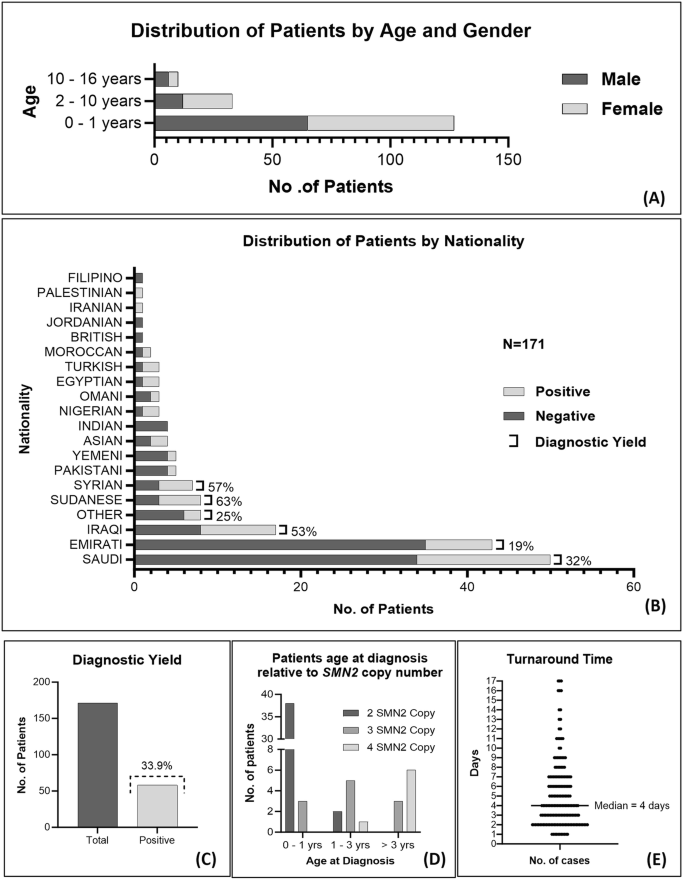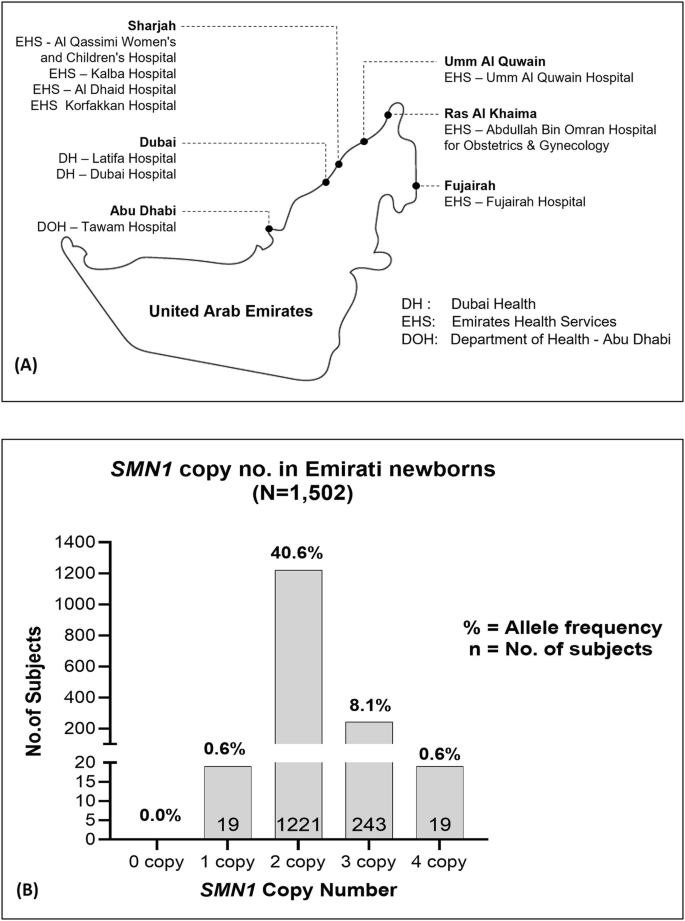Distribution of SMA patients and diagnostic yield in a multi-Arab population
Between June 2019 and August 2023, 171 pediatric patients (51% female; mostly infants) (Fig. 2A) presenting with hypotonia and/or muscle weakness were referred to the Al Jalila Genomic Center for SMA diagnostic testing. The patients, representing 18 countries, were predominantly Arab (82%) with the majority from Saudi Arabia (29%), the United Arab Emirates (25%), and Iraq (10%) ( Fig. 2B ).

or Distribution of patients by age and gender. B Distribution of patients (n = 171) and diagnostic yield by nationality. C Overall diagnostic yield. D SMN2 copy number status in spinal muscular atrophy patients of different ages. E Test return time.
Testing was positive in 58 cases, constituting an overall diagnostic yield of 33.9% (Fig. 2C), which varied by nationality (Fig. 2B); the yield was significantly higher among patients from Iraq (53%) compared to the United Arab Emirates (19%) (P = 0.012; Fisher’s exact test). Determination of SMN2 Copy number in SMA positive cases showed that the majority (71%) had 2 SMN2 copies, consistent with an earlier onset (Fig. 2D) and a more likely severe phenotype (SMA type I)7,12. The median test turnaround time was 5 business days, with more than half (56%) receiving results in ≤4 business days ( Fig. 2E ).
SMA epidemiology in the United Arab Emirates
We attempted to estimate the incidence of SMA in the UAE using the number of Emirati SMA patients born in a given year, as diagnosed by our laboratory during this period, divided by the total annual live births in this population ( which was 31,064 in 2021)13. However, as not all SMA diagnostic tests in the UAE are referred to our laboratory and due to the lack of a national SMA registry, it is likely that this clinic-based incidence estimate is inaccurate.
To gain better insight into SMA epidemiology in the United Arab Emirates, we genetically screened a total of 1502 newborns (51% male, 49% female) recruited from 10 local maternity hospitals across the country ( Fig. 3A ). Neonates aged ≤3 months and were generally healthy with no family history of SMA. Results from the genetic screening revealed that 19 newborns (47% female, 53% male) were carriers of SMN1 deletion (Fig. 3B), showing a carrier frequency of 1 in 79 (1.3%) and an SMA allele frequency (q) of 0.0063 (Table 1). None of the newborns tested were homozygous SMN1 deletion.

or Recruitment sites across the UAE. B The distribution of SMN1copy number in tested Emirati newborns (N= 1502). EHS Emirates Health Services, DH Dubai Health, DOH Department of Health.
Assuming Hardy-Weinberg equilibrium, the disease burden or incidence (q2) can be estimated as 1 in 25,000 individuals. However, given the non-random mating in this population, a more appropriate estimate for the incidence would be qxf14where F represents the inbreeding coefficient in the Emirates population (F= 0.0222)15resulting in an incidence of 1 in 7122 individuals (Table 1).
It is important to note that this is likely to be an underestimate since (1) our test method only detects deletions that account for 92% of cases, while (2) this method does not distinguish silent carriers who possess two copies of SMN1gene in one allele (0 + 2), from normal noncarriers (1 + 1).
SMA epidemiology in other Arab populations
Genetic studies of newborn screening have been limited in most Arab countries. A study from Morocco reported a carrier frequency of 1 in 25 and a prevalence of 1:1900, although this was based on a small sample of 150 Moroccan newborns.16. While this work was in preparation, a study was published in which screening of 4189 normal Saudi volunteers determined a carrier frequency of 1 in 3817. Using this SMA allele frequency, and the coefficient of inbreeding in Saudi Arabia18we estimated the incidence of SMA in this country to be 1 in 3192 (Table 1), which is consistent with that estimated by the authors in this study (32 in 100,000 or 1 in 3125 births)17. These estimates suggest that SMA carrier frequency and incidence in Saudi Arabia are both higher than those estimated in the UAE; findings which may be consistent with the observed higher SMA diagnostic trend in Saudi patients compared to those in the United Arab Emirates (Fig. 2B).
The case for premarital genomic screening
The tragic loss of an infant to SMA in Australia has prompted a large-scale reproductive carrier screening program for 750 genetic conditions (the “Mackenzie Mission”) in Australia.19. The estimated incidence of SMA in the two Arab countries studied here is higher than that in other populations worldwide.7a finding which is consistent with the expected higher incidence of recessive disorders in Arab populations, suggesting that premarital genetic screening is likely to be an effective preventive measure in those populations.
Based on the above estimate of the incidence of SMA in the UAE (Table 1) and the average annual birth rate in the Emirates, we conservatively predict that 4 births per year will be affected by SMA, requiring gene therapy at a cost total of $8.4 million ($2.1 million other long-term treatment options, such as Spinraza, have a higher cost). However, if SMA premarital screening is implemented, the total estimated cost of screening marriages in the Emirates would be $0.49 million per year (Table 2). Couples at risk (N= 4) will have the option of pre-implementation genetic testing (PGT) and in vitro fertilization (IVF) at a cost of up to $30,000 per couple20 (Table 2).
Similarly, the average annual number of births among Saudi nationals (18.8 million) is 511,00021,22. Therefore, it is expected that 160 births are affected by SMA per year, requiring 336 million dollars for treatment. However, the cost of SMA premarital screening for the 141,000 annual Saudi marriages in KSA22it would be about $7 million, along with a total cost of $4.8 million in PGT/IVF for at-risk couples (Table 2).
We estimate the disease burden or incidence of SMA in the United Arab Emirates. Using data from the United Arab Emirates (this study) and Saudi Arabia17, we demonstrate that, in addition to potentially preventing new SMA cases, premarital screening and subsequent PGT/IVF for at-risk couples can be a highly cost-effective public health measure, leading to an expected 14 to 28 times. cost reduction compared to treatment of postpartum illness. Interestingly, the cost savings due to premarital screening for this disease (~$8 million in the UAE and $324 million in KSA) are sufficient to fund more comprehensive premarital genomic screening programs that include hundreds of recessive disorders in both countries. We strongly support the implementation of comprehensive premarital genomic screening in Arab populations with similarly high levels of consanguinity.
#Genetic #epidemiology #spinal #muscular #atrophy #case #premarital #genomic #screening #Arab #populations #Medicine #Communication
Image Source : www.nature.com